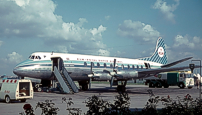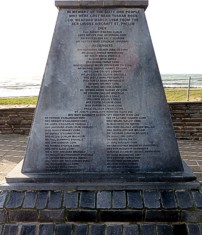
November 1957 to November 1966
Koninklijke Luchtvaart Maatschappij N.V. (KLM)
PH-VIG - c/n 178 - a V.803 series Viscount
Netherlands registered
June 1955
An order for nine Type 803 was placed by Koninklijke Luchtvaart Maatschappij N.V. (KLM).
This was the 7th aircraft for KLM.
Production Aircraft No. 36 - the 36th production 800 series Viscount built,
was the 28th 800 series Viscount fuselage assembled at Hurn, Bournemouth, Hampshire, England,
and the 36th 800 series Viscount assembled at Weybridge, Surrey, England.
Production Order No. F07/803. Sales Order No. F07/83B. Stock Order No. F29/26B.
8 March 1957
Fuselage assembly commenced at Hurn Airport, Bournemouth, Hampshire, England.
May 1957
Fuselage transported by road from Hurn Airport, Bournemouth, Hampshire, England to Weybridge, Surrey, England.
8 May 1957
Fuselage to Erecting Shop 'E' at Weybridge, Surrey, England.
18 October 1957
First flight from Brooklands Airfield, Weybridge, Surrey, England.
It landed at Wisley Airfield, Surrey, England for fitting out and test flying.
22 October 1957
Delivered to Koninklijke Luchtvaart Maatschappij N.V. (KLM) named as 'Sir Charles Kingsford Smith' with a 53 seat mixed-class cabin.
The original livery had ‘The Flying Dutchman’ titles on the port side and ‘De Vliegende Hollander’ titles on the starboard side.
The cabin seating was later increased to 59/64 all-tourist class configuration.
12 January 1960
During the approach to Schiphol Airport, Amsterdam, Netherlands the Captain reported a problem with the nose landing gear not locking.
He elected to make a low pass along the runway so that the emergency fire crew on the ground could make an assessment. As everything appeared to be normal a landing was made without incident.

KLM
'diagonal striped tail' livery.
circa 1960
Painted in the new KLM 'diagonal striped tail' livery with ‘KLM - Royal Dutch Airlines’ titles.
1 April 1960
Noted at Blackbushe Airport, Hampshire, England on a London Airport weather diversion.
22 February 1961
Suffered a port main undercarriage malfunction on flight KL103 from Rotterdam to London.
On approach to London Airport (Heathrow), Middlesex, England at approximately 10:00 hours with the undercarriage lowered, the port main undercarriage safe light would not go green. Captain P J van der Laan decided to return to the Netherlands and make a belly landing at Schiphol Airport, Amsterdam, Netherlands.
Runway 05 at Schiphol Airport was prepared for the emergency landing and foam was laid down and fire and ambulance vehicles were in attendance.
After a few low passes along runway 32 Captain P J van der Laan announced that he would make a wheels down landing on runway 01 and the emergency vehicles transferred to this runway.
An uneventful landing was subsequently carried out at 11:47 hours local time, with the local press now in attendance. Other crew members were First Officer H Heus, Stewardess J Kant, Purser L W de Pater and Cabin Chief C J Jansen.
It is presumed that the visual indicator on top of the wing convinced the Captain that the undercarriage was safely down and locked and that it was just an electrical fault. It certainly prevented a lot of damage to the propellers, fuselage belly and flaps and shockloading to the Rolls-Royce Dart engines.
Information source: - De Courant Nieuws van de Dag 22/02/61 via Herman Dekker.

KLM
'horizontal striped tail' livery
circa 1965
Painted in the new KLM 'horizontal striped tail' livery.
3 November 1966
Sold to Aer Lingus.
|

November 1966 to March 1968
Aer Lingus - Irish International Airlines
EI-AOM - c/n 178 - a V.803 series Viscount
Ireland registered
3 November 1966
Purchased from Koninklijke Luchtvaart Maatschappij N.V. (KLM) and named as 'St Feidhlim' / 'St Phelim'.
24 November 1966
Dutch registration cancelled.
24 March 1968
Crashed into the Irish Sea near Tuskar Rock, which is 6.8 miles (11 km) off the coast of County Wexford, Ireland, sadly with the loss of all 57 passengers and 4 crew.
The registration was cancelled the same day.
Aer Lingus flight EI 712 had departed Cork Airport, Ballygarvan, Ireland at 10:32 local time for a direct service to Heathrow Airport, London, England and was cleared to FL170 (17,000 feet). The crew sent out a radio message at the Bannow reporting point at 10:57 local time stating that they were at FL170. They were instructed to change frequency to London Airways.
Just eight seconds after first reporting to London ATC a broken message was received which was later interpreted as 'Twelve thousand feet descending spinning rapidly'. The Viscount descended and struck the sea 1.7 nautical miles from Tuskar Rock.
After the loss of contact, Air Traffic Control requested that Aer Lingus flight EI 362 which was heading to Bristol from Dublin divert to an area west of the Strumble to see if they could spot anything on the water. They descended to 500 feet but nothing was seen.
At 11:25 a full alert was sounded. HMS Hardy, a Royal Navy Type 14 Frigate was the first ship to reach the possible crash area but found nothing. It wasn't until the search resumed on the following day that floating debris was sighted and over the next few days a total of fourteen bodies were recovered. The main wreckage was detected on the seabed by a trawler at a depth of 39 fathoms (234 feet / 71.3 metres), 1.7 miles from Tuskar Rock.
The crew members were Captain Bernard 'Barney' O'Beirne aged 35 who had joined Aer Lingus from the Irish Air Corps and had a total of 6,683 hours flying experience, 1,679 on the Viscount. The First Officer was Paul Heffernan aged 22 who trained at Airwork Services based at Scone, Perth, Scotland and joined Aer Lingus in 1966. He had a total of 1,139 hours with 900 hours experience on the Viscount. The two Stewardesses were Mary Coughlan and Ann Kelly.
The list of passenger names were: - Katherine Archer, Dennis Arnold, Roger Baeck, Dr Hans Beck, Elizabeth Bryan, Hannah Burke, Michael Cowhig, William Cox-Ife, Jacques Creyelman, Sheila Dann, Teresa Dann, Rory Delaney, Pierre Dreyfus , Thomas Dwane, Edmund Faveurs, Karin Gahlin, Sven Gahlin, Eileen Gallivan, Marion Gallivan, Paula Gallivan, Joseph Ganglehoff, Mary Ganglehoff, Edward Hegarty, Maura Herlihy, Max Hinderer, Eileen Jephson, Maurice Jephson, Theordor Jurgens, Anthony Long, Curt Meyer, Noel Mulcahy, Christopher McCarthy, Jeremiah McCarthy, Rita McCarthy, Neill McCormick, Dorthy Newey, Richard Nunan, John Nyhan, Edward O’Brien, Bridget O’Callaghan, Patrick O’Callaghan, James O’Halloran, Josephine O’Halloran, Nora O’Mahony, Barney O’Rourke, Nellie Quinlan, Paul Schwartz, Ann Shorten, Thomas Shorten, Ruth Sless, Albert Spleleers, Marcel Vastenavondt, Madeleine Waeckerling, Roland Waeckerling, Desmond Walls, Rudolf Weiss and Ernest Zimmerman.
PROBABLE CAUSE: 'There is not enough evidence available on which to reach a conclusion of reasonable probability as to the initial cause of this accident. The probable cause of the final impact with the sea was impairment of the controllability of the aircraft in the fore and aft (pitching) plane.'
A Report of the investigation carried out into this accident was published in 1970. This investigation was conducted by officials of the Aeronautical Section of the Department of Transport and Power. The exact cause of the accident has never been established (see the Probable Cause above).
Speculation has continued since the time of the accident, prompted by a hypothesis posed in the report, that the Viscount may have been initially upset by the possible presence of another airborne object, drone or missile in its vicinity at the time. On the 30th anniversary of the accident, following newspaper articles and television programmes focusing on the possible involvement of UK ships and missile ranges on the Welsh Coast in the downing of the aircraft, it was decided that Irish and UK officials would review all files held relating to the accident to see if the cause of the accident could be established.
It was concluded that 'the possibility of a cause other than a (near) collision with another airborne object being the initial cause of the upset ….. Does not appear to have been adequately examined in the 1970 Report.' Following the review, in July 2000, the Irish Minister for Public Enterprise commissioned this independent study of the accident circumstances. The study conclusions, although not in ICAO Annex 13 format, indicate that: -
a. There was no other airborne object, missile, or drone in the vicinity of the upset.
b. The flight path, supported by a mix of 46 new and previous witnesses, cannot be reconciled with two alleged transmissions from the crew at 10.51 GMT and at 10.57 GMT i.e. 'Level at 170', shown in transcripts.
c. Some maintenance compliance periods were exceeded by a factor of four e.g. jobs carried out at 1,400 flying hours but actually scheduled at 350 hours.
d. There was a conflict of interest in the original 1970 report inasmuch as the person in charge of that report was also the same man who authorised the C of A renewal for EI-AOM shortly before the crash, despite the fact that the paperwork for the ‘2.04’ Inspection was missing and remains lost.
e. The initial upset occurred circa 10.40 hours GMT at about FL90 during the climb above the village of Old Parish in County Waterford. The aircraft was recovered from the dive and flew an erratic path inland until 10.58 GMT when there was a second spin or spiral dive from which the crew also recovered the aircraft. Total loss of control then occurred some minutes later near Tuskar Rock.
About a week before the accident, this aircraft was used on a training exercise to simulate decompression at altitude resulting in pulling out from high speed dives which subjected the tailplane to high G loadings. The pilot being trained at the time reported this to the accident enquiry but never heard if this was considered as a possible cause, i.e. stress induced structural failure. In view of the length of time this aircraft kept flying 'under-difficulty' this scenario would seem to be unlikely. A failure similar to Viscount c/n 353 PK-IVS would seem more likely.
Total time 18,807 hours and 16,923 landings.
The official accident report and subsequent reviews can be found in modern PDF format on the following website: - www.aaiu.ie/node/5

The memorial stone at Kilmore Quay, County Wexford, Irelandy.
A memorial stone has been erected at the pretty fishing village of Kilmore Quay, County Wexford, Ireland and lists all the names of those on board who lost their lives in this tragic event.
 FURTHER READING: Books about Aer Lingus FURTHER READING: Books about Aer Lingus
|



